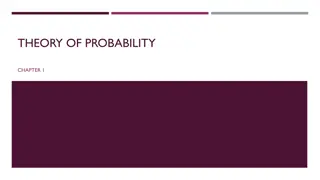Understanding Two-Way Tables and Probability
Two-way tables are used to display data collected from two different categories. By organizing data in a two-way table, you can find joint frequencies, marginal frequencies, and interpret the results. In this context, learn how to create two-way tables, calculate marginal frequencies, find joint frequencies, and understand conditional probabilities through practical examples.
Uploaded on Oct 03, 2024 | 0 Views
Download Presentation

Please find below an Image/Link to download the presentation.
The content on the website is provided AS IS for your information and personal use only. It may not be sold, licensed, or shared on other websites without obtaining consent from the author. Download presentation by click this link. If you encounter any issues during the download, it is possible that the publisher has removed the file from their server.
E N D
Presentation Transcript
Two-Way Tables and Probability Section 10.3
Making Two-Way Tables A two-way table is a frequency table that displays data collected from one source that belong to two different categories. One category of data is represented by rows and the other is represented by columns. Each entry in the table is called a joint frequency. The sums of the rows and columns are called marginal frequencies,
In another survey similar to the one above, 106 juniors and 114 seniors respond. Of those, 42 juniors and 77 seniors plan on attending. Organize these results in a two-way table. Then find and interpret the marginal frequencies. Step 1 Find the joint frequencies. Because 42 of the 106 juniors are attending, 106 42 = 64 juniors are not attending. Because 77 of the 114 seniors are attending, 114 77 = 37 seniors are not attending. Place each joint frequency in its corresponding cell. Step 2 Find the marginal frequencies. Create a new column and row for the sums. Then add the entries and interpret the results.
Step 3 Find the sums of the marginal frequencies. Notice the sums 106 + 114 = 220 and 119 + 101 = 220 are equal. Place this value at the bottom right.
Finding Joint and Marginal Relative Frequencies
Comparing Conditional Probabilities A jogger wants to burn a certain number of calories during his workout. He maps out three possible jogging routes. Before each workout, he randomly selects a route, and then determines the number of calories he burns and whether he reaches his goal. The table shows his findings. Which route should he use?
A manager is assessing three employees in order to offer one of them a promotion. Over a period of time, the manager records whether the employees meet or exceed expectations on their assigned tasks. The table shows the manager s results. Which employee should be offered the promotion? Explain.
Modelling with Mathematics You survey 171 males and 180 females at Grand Central Station in New York City. Of those, 132 males and 151 females wash their hands after using the public rest rooms. Organize these results in a two-way table. Then find and interpret the marginal frequencies.























